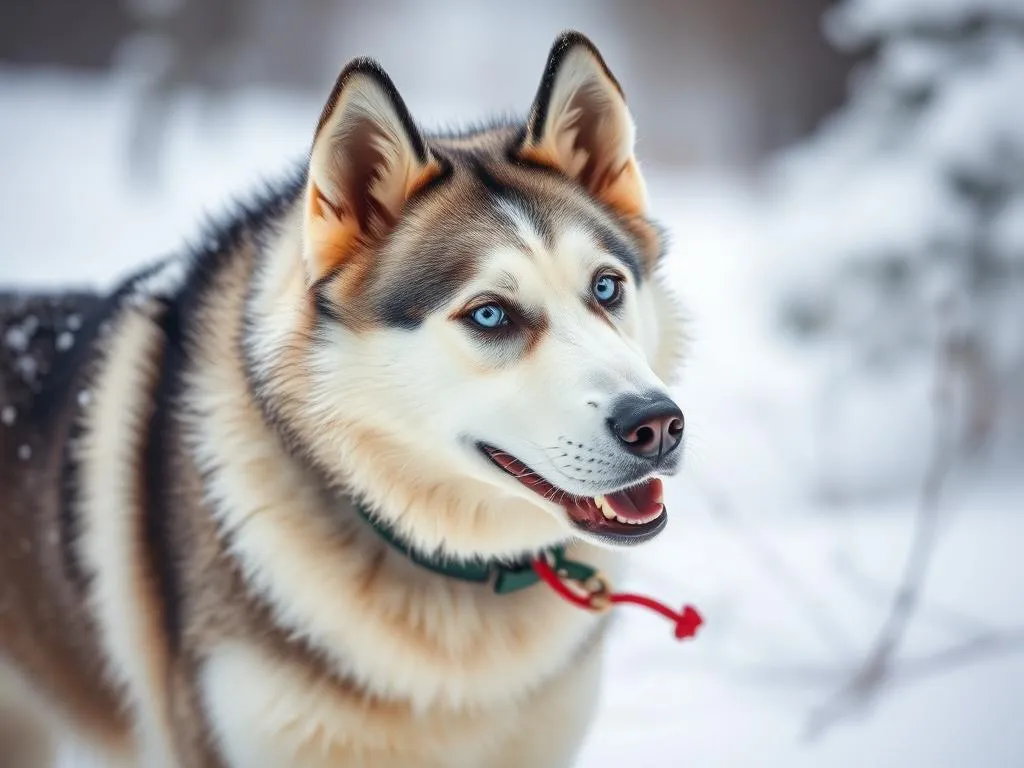
The Siberian Husky is a remarkable breed known for its striking appearance and unparalleled ability to thrive in cold climates. Originating from the harsh, frigid regions of Siberia, these dogs were bred by the Chukchi people to pull sleds and herd reindeer. Their history is deeply intertwined with the need to adapt to extreme weather conditions, making them one of the best breeds suited for cold environments.
Understanding how do Huskies survive in the cold involves delving into their unique anatomical features, behavioral patterns, physiological adaptations, dietary needs, and the proper care they require. Each of these elements plays a crucial role in ensuring that these resilient dogs not only survive but thrive in icy conditions.
The Anatomy of a Siberian Husky
Double Coat
One of the most distinctive features of the Siberian Husky is its double coat. This coat consists of two layers: the outer layer, known as guard hairs, and the inner layer, known as the undercoat.
- Guard Hairs: These longer, coarser hairs repel snow and water, preventing moisture from reaching the skin. They also provide protection from the harsh elements.
- Undercoat: This layer is soft and dense, providing insulation against the cold. It traps air, creating a barrier that helps maintain body heat.
The insulation properties of each layer are vital for keeping Huskies warm in frigid temperatures. Interestingly, Huskies will shed their undercoat in warmer months to adapt to the changing climate, which can affect their insulation. During the shedding season, owners must be diligent in grooming to help manage the fur loss and maintain the coat’s effectiveness.
Body Structure
The body structure of a Husky is another crucial factor in its ability to withstand cold weather. Huskies are medium-sized dogs with a well-proportioned body that balances strength and agility.
- Comparison to Other Breeds: Unlike heavier breeds that may struggle in deep snow, Huskies are lighter and more athletic, allowing them to move efficiently through icy terrain.
- Fat Distribution and Muscle Composition: Huskies have a low-fat distribution that helps maintain mobility, while their muscle composition aids in generating heat. This combination allows them to remain active and agile, even in the snow.
The overall body shape of a Husky, characterized by a rounded skull, erect ears, and a bushy tail, also plays a role in their cold-weather survival. The tail can be curled over the nose when sleeping, providing additional warmth.
Paws Adaptations
Huskies possess unique paw adaptations that enhance their ability to navigate cold environments.
- Fur Between Toes: This fur provides insulation and prevents ice and snow from accumulating between their toes, which can be uncomfortable and even painful.
- Wider Feet: The structure of their paws is wider than many other breeds, offering better traction on snow and ice. This adaptability allows them to run and maneuver effectively in challenging conditions.
Behavioral Adaptations
Social Structure and Pack Behavior
Huskies are inherently social animals, and their pack behavior is crucial for survival in cold climates. They thrive in groups, relying on their pack mentality to work together effectively.
- Importance of Pack Mentality: In the wild, Huskies hunt and travel in packs, which helps them share resources and protect one another from the elements.
- Working Together in Extreme Conditions: In sledding scenarios, Huskies demonstrate remarkable teamwork, pulling together to navigate through snowstorms and cold temperatures.
Their social nature cultivates not only resilience but also a sense of security, ensuring their survival in harsh environments.
Activity Levels
Huskies are known for their high activity levels, which play a significant role in their ability to adapt to cold environments.
- Role of High Energy: These dogs require significant exercise, which helps maintain their body temperature. Regular activity boosts their metabolism, generating heat and keeping them warm.
- Impact of Exercise on Body Temperature Regulation: Engaging in vigorous activities like running or playing helps Huskies regulate their body temperature even in frigid conditions, allowing them to thrive.
Nesting and Shelter-Seeking Behavior
Huskies possess natural instincts for finding or creating warm shelters.
- Nesting Behaviors: In the wild, they will dig into the snow to create a warm place to rest. This instinctive behavior helps them conserve heat and protect themselves from the wind.
- Examples in the Wild: Huskies will often seek out natural formations, such as hollowed-out areas or sheltered spots, to protect themselves from the elements.
These behaviors showcase their adaptability and ingenuity in ensuring their survival.
Physiological Adaptations
Metabolic Rate
A Siberian Husky’s metabolic rate is essential for maintaining body heat in cold weather.
- Maintaining Body Heat: Huskies have a higher basal metabolic rate than many other breeds, allowing them to generate heat efficiently. This helps them stay warm even during prolonged exposure to low temperatures.
- Energy Requirements: Their energy needs increase in cold weather, requiring a diet that can support their active lifestyle and help maintain their body temperature.
Blood Circulation Adaptations
Huskies have developed specific mechanisms for blood circulation that are crucial during cold weather.
- Blood Flow Regulation: In cold temperatures, their bodies can constrict blood vessels near the skin to conserve heat, redirecting blood flow to vital organs.
- Importance of Peripheral Circulation: This adaptation is vital for protecting extremities like paws and ears, ensuring they remain functional and warm.
These physiological traits contribute significantly to their remarkable ability to withstand cold environments.
The Role of Diet in Cold Survival
Nutritional Needs
A well-balanced diet is essential for Huskies, especially in cold climates.
- Impact on Energy and Body Temperature: Proper nutrition helps maintain energy levels, which is crucial for generating body heat. A diet rich in proteins and fats is recommended to support their active lifestyle.
- Recommended Foods: High-quality dog food formulated for active breeds can provide the necessary nutrients. Foods rich in omega fatty acids can also support a healthy coat, enhancing insulation.
Hydration in Cold Weather
Despite the cold, hydration remains vital for Huskies.
- Importance of Water Intake: Even in winter, dogs can become dehydrated. Water is essential for maintaining their overall health and regulating body temperature.
- Acquiring Hydration from Snow and Ice: Huskies can consume snow and ice to hydrate, but this should not be their sole source of water. Always ensure they have access to fresh, unfrozen water.
Training and Care for Cold Environments
Acclimatization Process
Introducing Huskies to extreme cold requires a gradual acclimatization process.
- Gradual Introduction: Start with short outdoor sessions, gradually increasing the duration as they become accustomed to the temperature. This helps them develop the necessary tolerance to cold.
- Signs of Discomfort: Be vigilant for signs of discomfort, such as shivering, whining, or reluctance to move. If you notice these signs, it’s essential to bring them indoors or provide warmth promptly.
Gear and Equipment
While Huskies are naturally equipped to handle cold weather, certain gear and equipment can enhance their comfort.
- Winter Gear: Consider using dog boots to protect their paws from ice and salt, especially in urban areas. Jackets can provide additional warmth for particularly frigid days.
- Choosing the Right Gear: Ensure that any gear fits properly and allows for natural movement. Look for materials that are both insulating and water-resistant.
Common Myths about Huskies and Cold Weather
Huskies Can’t Be Kept Indoors
One common misconception is that Huskies can’t be kept indoors. In reality, Huskies are adaptable and can thrive in various living conditions.
- Adaptability to Living Conditions: Many Huskies live happily indoors, provided they receive regular exercise and mental stimulation.
- Proper Care and Exercise: It’s crucial to offer them daily activities to keep their energy levels balanced and prevent boredom.
Huskies Don’t Need Extra Care in Winter
Another myth is that Huskies don’t need extra care in winter. This is far from the truth.
- Common Misconceptions: While they are better equipped for the cold than many breeds, they still require care and attention.
- Regular Veterinary Check-Ups: Routine check-ups during winter months are essential to monitor their health, particularly their paws, skin, and overall condition.
Conclusion
Siberian Huskies are incredible dogs, uniquely adapted to thrive in cold climates. Their double coats, specialized body structure, and behavioral traits all contribute to their remarkable survival skills in icy conditions. With the right care, nutrition, and understanding of their needs, owners can ensure their Huskies lead happy, healthy lives, even in the heart of winter. Understanding how do Huskies survive in the cold not only fosters a deeper appreciation for this resilient breed but also guides responsible ownership and care.
This exploration into the adaptations and behaviors of Huskies highlights their resilience and adaptability, encouraging all dog lovers to reflect on the needs of this extraordinary breed in cold environments.









